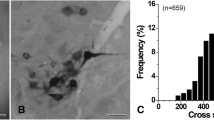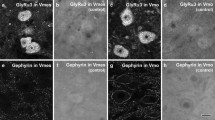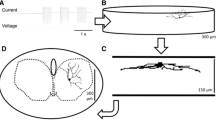Abstract
Detailed information about the development of excitatory and inhibitory synapses on the genioglossal (GG) motoneuron may help to understand the mechanism of fine control of GG motoneuron firing and the coordinated tongue movement during postnatal development. For this, we investigated the development of γ-aminobutyric acid (GABA)-immunopositive (GABA +), glycine + (Gly +), and glutamate + (Glut +) axon terminals (boutons) on the somata of rat GG motoneurons at a postnatal day 2 (P2), P6 and P18 by retrograde labeling of GG motoneurons with horseradish peroxidase, electron microscopic postembedding immunogold staining with GABA, Gly, and Glut antisera, and quantitative analysis. The number of boutons per GG motoneuron somata and the mean length of bouton apposition, measures of bouton size and synaptic covering percentage, were significantly increased from P2/P6 to P18. The number and fraction of GABA + only boutons of all boutons decreased significantly, whereas those of Gly + only boutons increased significantly from P2/P6 to P18, suggesting developmental switch from GABAergic to glycinergic synaptic transmission. The fraction of mixed GABA +/Gly + boutons of all boutons was the highest among inhibitory bouton types throughout the postnatal development. The fractions of excitatory and inhibitory boutons of all boutons remained unchanged during postnatal development. These findings reveal a distinct developmental pattern of inhibitory synapses on the GG motoneurons different from that on spinal or trigeminal motoneurons, which may have an important role in the regulation of the precise and coordinated movements of the tongue during the maturation of the oral motor system.







Similar content being viewed by others
References
Apostolova G, Dechant G (2009) Development of neurotransmitter phenotypes in sympathetic neurons. Auton Neurosci 151:30–38. https://doi.org/10.1016/j.autneu.2009.08.012
Aubrey KR (2016) Presynaptic control of inhibitory neurotransmitter content in VIAAT containing synaptic vesicles. Neurochem Int 98:94–102. https://doi.org/10.1016/j.neuint.2016.06.002
Aubrey KR, Supplisson S (2018) Heterogeneous signaling at GABA and glycine co-releasing terminals. Front Synaptic Neurosci 10:40. https://doi.org/10.3389/fnsyn.2018.00040
Bae JY, Lee JS, Ko SJ, Cho YS, Rah JC, Cho HJ, Park MJ, Bae YC (2018) Extrasynaptic homomeric glycine receptors in neurons of the rat trigeminal mesencephalic nucleus. Brain Struct Funct 223:2259–2268. https://doi.org/10.1007/s00429-018-1607-3
Berger AJ (2011) Development of synaptic transmission to respiratory motoneurons. Respir Physiol Neurobiol 179:34–42. https://doi.org/10.1016/j.resp.2011.03.002
Broman J, Anderson S, Ottersen OP (1993) Enrichment of glutamate-like immunoreactivity in primary afferent terminals throughout the spinal cord dorsal horn. Eur J Neurosci 5:1050–1061. https://doi.org/10.1111/j.1460-9568.1993.tb00958.x
Carrascal L, Nieto-Gonzalez JL, Cameron WE, Torres B, Nunez-Abades PA (2005) Changes during the postnatal development in physiological and anatomical characteristics of rat motoneurons studied in vitro. Brain Res Brain Res Rev 49:377–387. https://doi.org/10.1016/j.brainresrev.2005.02.003
Chery N, De Koninck Y (2000) GABA(B) receptors are the first target of released GABA at lamina I inhibitory synapses in the adult rat spinal cord. J Neurophysiol 84:1006–1011. https://doi.org/10.1152/jn.2000.84.2.1006
Cragg BG (1975) The development of synapses in the visual system of the cat. J Comp Neurol 160:147–166. https://doi.org/10.1002/cne.901600202
Dulcis D, Jamshidi P, Leutgeb S, Spitzer NC (2013) Neurotransmitter switching in the adult brain regulates behavior. Science 340:449–453. https://doi.org/10.1126/science.1234152
Gao BX, Stricker C, Ziskind-Conhaim L (2001) Transition from GABAergic to glycinergic synaptic transmission in newly formed spinal networks. J Neurophysiol 86:492–502. https://doi.org/10.1152/jn.2001.86.1.492
Gao XP, Liu QS, Liu Q, Wong-Riley MT (2011) Excitatory-inhibitory imbalance in hypoglossal neurons during the critical period of postnatal development in the rat. J Physiol 589:1991–2006. https://doi.org/10.1113/jphysiol.2010.198945
Habecker BA, Tresser SJ, Rao MS, Landis SC (1995) Production of sweat gland cholinergic differentiation factor depends on innervation. Dev Biol 167:307–316. https://doi.org/10.1006/dbio.1995.1025
Hashimoto K, Kano M (2013) Synapse elimination in the developing cerebellum. Cell Mol Life Sci 70:4667–4680. https://doi.org/10.1007/s00018-013-1405-2
Hinds JW, Hinds PL (1976) Synapse formation in the mouse olfactory bulb. I. Quantitative studies. J Comp Neurol 169:15–40. https://doi.org/10.1002/cne.901690103
Horner RL (2009) Emerging principles and neural substrates underlying tonic sleep-state-dependent influences on respiratory motor activity. Philos Trans R Soc Lond B Biol Sci 364:2553–2564. https://doi.org/10.1098/rstb.2009.0065
Inquimbert P, Rodeau JL, Schlichter R (2007) Differential contribution of GABAergic and glycinergic components to inhibitory synaptic transmission in lamina II and laminae III–IV of the young rat spinal cord. Eur J Neurosci 26:2940–2949. https://doi.org/10.1111/j.1460-9568.2007.05919.x
Kolston J, Osen KK, Hackney CM, Ottersen OP, Storm-Mathisen J (1992) An atlas of glycine- and GABA-like immunoreactivity and colocalization in the cochlear nuclear complex of the guinea pig. Anat Embryol (Berl) 186:443–465
Lim R, Alvarez FJ, Walmsley B (2000) GABA mediates presynaptic inhibition at glycinergic synapses in a rat auditory brainstem nucleus. J Physiol 525(Pt 2):447–459. https://doi.org/10.1111/j.1469-7793.2000.t01-1-00447.x
Liu Q, Wong-Riley MT (2005) Postnatal developmental expressions of neurotransmitters and receptors in various brain stem nuclei of rats. J Appl Physiol 98:1442–1457. https://doi.org/10.1152/japplphysiol.01301.2004
Liu Q, Wong-Riley MT (2010) Postnatal development of N-methyl-d-aspartate receptor subunits 2A, 2B, 2C, 2D, and 3B immunoreactivity in brain stem respiratory nuclei of the rat. Neuroscience 171:637–654. https://doi.org/10.1016/j.neuroscience.2010.09.055
Liu X, Sood S, Liu H, Nolan P, Morrison JL, Horner RL (2003) Suppression of genioglossus muscle tone and activity during reflex hypercapnic stimulation by GABA(A) mechanisms at the hypoglossal motor nucleus in vivo. Neuroscience 116:249–259
Lu T, Rubio ME, Trussell LO (2008) Glycinergic transmission shaped by the corelease of GABA in a mammalian auditory synapse. Neuron 57:524–535. https://doi.org/10.1016/j.neuron.2007.12.010
Meng D, Li HQ, Deisseroth K, Leutgeb S, Spitzer NC (2018) Neuronal activity regulates neurotransmitter switching in the adult brain following light-induced stress. Proc Natl Acad Sci USA 115:5064–5071. https://doi.org/10.1073/pnas.1801598115
Muller E, Triller A, Legendre P (2004) Glycine receptors and GABA receptor alpha 1 and gamma 2 subunits during the development of mouse hypoglossal nucleus. Eur J Neurosci 20:3286–3300. https://doi.org/10.1111/j.1460-9568.2004.03785.x
Muller E, Le Corronc H, Triller A, Legendre P (2006) Developmental dissociation of presynaptic inhibitory neurotransmitter and postsynaptic receptor clustering in the hypoglossal nucleus. Mol Cell Neurosci 32:254–273. https://doi.org/10.1016/j.mcn.2006.04.007
Nabekura J, Katsurabayashi S, Kakazu Y, Shibata S, Matsubara A, Jinno S, Mizoguchi Y, Sasaki A, Ishibashi H (2004) Developmental switch from GABA to glycine release in single central synaptic terminals. Nat Neurosci 7:17–23. https://doi.org/10.1038/nn1170
Nagata S, Nakamura S, Nakayama K, Mochizuki A, Yamamoto M, Inoue T (2016) Postnatal changes in glutamatergic inputs of jaw-closing motoneuron dendrites. Brain Res Bull 127:47–55. https://doi.org/10.1016/j.brainresbull.2016.08.014
O’Brien JA, Berger AJ (2001) The nonuniform distribution of the GABA(A) receptor alpha 1 subunit influences inhibitory synaptic transmission to motoneurons within a motor nucleus. J Neurosci 21:8482–8494
O’Brien JA, Sebe JY, Berger AJ (2004) GABA(B) modulation of GABA(A) and glycine receptor-mediated synaptic currents in hypoglossal motoneurons. Respir Physiol Neurobiol 141:35–45. https://doi.org/10.1016/j.resp.2004.03.009
O’Kusky JR (1998) Postnatal changes in the numerical density and total number of asymmetric and symmetric synapses in the hypoglossal nucleus of the rat. Brain Res Dev Brain Res 108:179–191. https://doi.org/10.1016/s0165-3806(98)00048-0
Oshima S, Fukaya M, Masabumi N, Shirakawa T, Oguchi H, Watanabe M (2002) Early onset of NMDA receptor GluR epsilon 1 (NR2A) expression and its abundant postsynaptic localization in developing motoneurons of the mouse hypoglossal nucleus. Neurosci Res 43:239–250. https://doi.org/10.1016/s0168-0102(02)00035-4
Ottersen OP, Storm-Mathisen J (1984) Glutamate- and GABA-containing neurons in the mouse and rat brain, as demonstrated with a new immunocytochemical technique. J Comp Neurol 229:374–392. https://doi.org/10.1002/cne.902290308
Ottersen OP, Storm-Mathisen J, Madsen S, Skumlien S, Stromhaug J (1986) Evaluation of the immunocytochemical method for amino acids. Med Biol 64:147–158
Paik SK, Bae JY, Park SE, Moritani M, Yoshida A, Yeo EJ, Choi KS, Ahn DK, Moon C, Shigenaga Y, Bae YC (2007) Developmental changes in distribution of gamma-aminobutyric acid- and glycine-immunoreactive boutons on rat trigeminal motoneurons. I. Jaw-closing motoneurons. J Comp Neurol 503:779–789. https://doi.org/10.1002/cne.21423
Paik SK, Park SK, Jin JK, Bae JY, Choi SJ, Yoshida A, Ahn DK, Bae YC (2011) Ultrastructural analysis of glutamate-immunopositive synapses onto the rat jaw-closing motoneurons during postnatal development. J Neurosci Res 89:153–161. https://doi.org/10.1002/jnr.22544
Paik SK, Kwak WK, Bae JY, Na YK, Park SY, Yi HW, Ahn DK, Ottersen OP, Yoshida A, Bae YC (2012) Development of gamma-aminobutyric acid-, glycine-, and glutamate-immunopositive boutons on rat jaw-opening motoneurons. J Comp Neurol 520:1212–1226. https://doi.org/10.1002/cne.22771
Paik SK, Yoo HI, Choi SK, Bae JY, Park SK, Bae YC (2019) Distribution of excitatory and inhibitory axon terminals on the rat hypoglossal motoneurons. Brain Struct Funct 224:1767–1779. https://doi.org/10.1007/s00429-019-01874-0
Pang YW, Li JL, Nakamura K, Wu S, Kaneko T, Mizuno N (2006) Expression of vesicular glutamate transporter 1 immunoreactivity in peripheral and central endings of trigeminal mesencephalic nucleus neurons in the rat. J Comp Neurol 498:129–141. https://doi.org/10.1002/cne.21047
Park SK, Lee DS, Bae JY, Bae YC (2016) Central connectivity of the chorda tympani afferent terminals in the rat rostral nucleus of the solitary tract. Brain Struct Funct 221:1125–1137. https://doi.org/10.1007/s00429-014-0959-6
Park SK, Ko SJ, Paik SK, Rah JC, Lee KJ, Bae YC (2018) Vesicular glutamate transporter 1 (VGLUT1)- and VGLUT2-immunopositive axon terminals on the rat jaw-closing and jaw-opening motoneurons. Brain Struct Funct 223:2323–2334. https://doi.org/10.1007/s00429-018-1636-y
Park SK, Hong JH, Jung JK, Ko HG, Bae YC (2019a) Vesicular Glutamate Transporter 1 (VGLUT1)- and VGLUT2-containing terminals on the rat jaw-closing gamma-motoneurons. Exp Neurobiol 28:451–457. https://doi.org/10.5607/en.2019.28.4.451
Park SK, Devi AP, Bae JY, Cho YS, Ko HG, Kim DY, Bae YC (2019b) Synaptic connectivity of urinary bladder afferents in the rat superficial dorsal horn and spinal parasympathetic nucleus. J Comp Neurol 527:3002–3013. https://doi.org/10.1002/cne.24725
Plowman L, Lauff DC, Berthon-Jones M, Sullivan CE (1990) Waking and genioglossus muscle responses to upper airway pressure oscillation in sleeping dogs. J Appl Physiol 68:2564–2573. https://doi.org/10.1152/jappl.1990.68.6.2564
Ronnevi LO (1977) Spontaneous phagocytosis of boutons on spinal motoneurons during early postnatal development. An electron microscopical study in the cat. J Neurocytol 6:487–504. https://doi.org/10.1007/BF01205215
Ronnevi LO (1979) Spontaneous phagocytosis of C-type synaptic terminals by spinal alpha-motoneurons in newborn kittens. An electron microscopic study. Brain Res 162:189–199. https://doi.org/10.1016/0006-8993(79)90283-x
Sanes DH, Reh TA, Harris WA (2012) Synapse formation and function. In: Sanes DH, Reh TA, Harris WA (eds) Development of the nervous system, 3rd edn. Elsevier, Amsterdam, pp 209–248
Singer JH, Berger AJ (2000) Development of inhibitory synaptic transmission to motoneurons. Brain Res Bull 53:553–560
Stanek E 4th, Cheng S, Takatoh J, Han BX, Wang F (2014) Monosynaptic premotor circuit tracing reveals neural substrates for oro-motor coordination. Elife 3:e02511. https://doi.org/10.7554/eLife.02511
Travers JB, Yoo JE, Chandran R, Herman K, Travers SP (2005) Neurotransmitter phenotypes of intermediate zone reticular formation projections to the motor trigeminal and hypoglossal nuclei in the rat. J Comp Neurol 488:28–47. https://doi.org/10.1002/cne.20604
Vaughn JE (1989) Fine structure of synaptogenesis in the vertebrate central nervous system. Synapse 3:255–285. https://doi.org/10.1002/syn.890030312
Vonhoff F, Keshishian H (2017) Activity-dependent synaptic refinement: new insights from Drosophila. Front Syst Neurosci 11:23. https://doi.org/10.3389/fnsys.2017.00023
Weinberg RJ, van Eyck SL (1991) A tetramethylbenzidine/tungstate reaction for horseradish peroxidase histochemistry. J Histochem Cytochem 39:1143–1148. https://doi.org/10.1177/39.8.1906909
Whitney GM, Ohtake PJ, Simakajornboon N, Xue YD, Gozal D (2000) AMPA glutamate receptors and respiratory control in the developing rat: anatomic and pharmacological aspects. Am J Physiol Regul Integr Comp Physiol 278:R520-528. https://doi.org/10.1152/ajpregu.2000.278.2.R520
Wojcik SM, Katsurabayashi S, Guillemin I, Friauf E, Rosenmund C, Brose N, Rhee JS (2006) A shared vesicular carrier allows synaptic corelease of GABA and glycine. Neuron 50:575–587. https://doi.org/10.1016/j.neuron.2006.04.016
Wong-Riley MT, Liu Q (2005) Neurochemical development of brain stem nuclei involved in the control of respiration. Respir Physiol Neurobiol 149:83–98. https://doi.org/10.1016/j.resp.2005.01.011
Yamane A (2005) Embryonic and postnatal development of masticatory and tongue muscles. Cell Tissue Res 322:183–189. https://doi.org/10.1007/s00441-005-0019-x
Acknowledgments
The authors sincerely thank Dr. Juli Valtschanoff for helpful discussion and careful reading of the manuscript. We also sincerely thank Dr. O.P. Ottersen for the gift of the glutamate, GABA and glycine antibodies and the sandwich block for the test sections.
Funding
This work was supported by the National Research Foundation of Korea (NRF) grant funded by the Korea government (MSIT, NRF-2017R1A5A2015391, NRF-2017R1A2B2003561).
Author information
Authors and Affiliations
Corresponding author
Ethics declarations
Conflict of interest
The authors declare that they have no conflict of interest.
Ethics approval
All applicable international, national, and/or institutional guidelines for the care and use of animals were followed. All procedures performed in studies involving animals were in accordance with the ethical standards of the institution or practice at which the studies were conducted.
Additional information
Publisher's Note
Springer Nature remains neutral with regard to jurisdictional claims in published maps and institutional affiliations.
Rights and permissions
About this article
Cite this article
Paik, S.K., Yoshida, A. & Bae, Y.C. Development of γ-aminobutyric acid-, glycine-, and glutamate-immunopositive boutons on the rat genioglossal motoneurons. Brain Struct Funct 226, 889–900 (2021). https://doi.org/10.1007/s00429-021-02216-9
Received:
Accepted:
Published:
Issue Date:
DOI: https://doi.org/10.1007/s00429-021-02216-9




